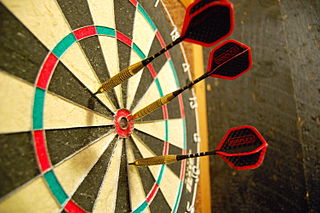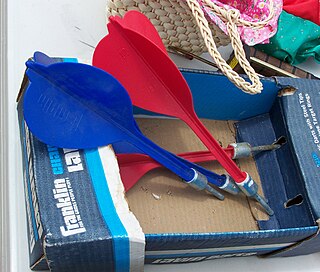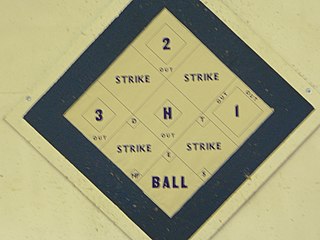
Cricket is a darts game that uses the standard 20 number dartboard with the triple and double rings. [1] [2]

Cricket is a darts game that uses the standard 20 number dartboard with the triple and double rings. [1] [2]
Cricket is typically played between 2, 3 or 4 players, or teams of players, although the rules do not discount more players. The goal of cricket is to be the first player to open or close all the cricket numbers and have a higher or even point total. [1]
Cricket uses the numbers 15 to 20 (or sometimes 10 to 20, and less frequently a predetermined selection of numbers) and the bullseye. To open or close a number, it must have been scored three times in any fashion, on one or more turns. Hitting the triple can open or close a number in one throw; a single and the double can open or close it in two throws or three singles can open or close it in three throws. Except in strict variants which count down from 20 to 15, numbers do not have to be opened or closed in any particular order and several numbers can be hit in the same turn. A scoreboard is used to keep track of the hits on all the numbers. Hitting a number once is shown by placing a slash (/) beside the number, second hit by turning the slash to an X, and the third by a circle (O) around the X. [1]
The object is for a player to hit each number and the bullseye three times. Doubles count as two hits and triples as three. [1] The outer bullseye counts as one and the inner bullseye as two. [1] The first player to hit a number three times owns that number and it is said to be opened. Further hits on the opened number score that number of points (e.g. triple 20 gains 60 points) until the opponent also hits that number three times and closes it, then that number is removed from play. The double ring scores double the number's value and the triple (inner) ring scores triple the number's value. The outer bullseye ring is worth 25 points and the inner circle (or double bull) is worth 50. Once a player has opened or closed all the required numbers and bull and has equal or more points than his opponent, that player wins. Also, if a player scores and does not record it before the next player goes, that score does not count.
Alternatively, cut-throat style scoring can be used, in which case points are undesirable; hitting a number that is opened results in points being given to any other players who do not have that number closed, and the lowest score wins. [3]
To start the game, each player or one player from each team throws one dart. This is known as the "diddle". The player whose dart lands closest to the center goes first. Generally, if both players' darts are in the same section of the bullseye, or in the event of a tie, each player throws another dart until there is an obvious winner. During a player's turn, the player throws three darts. After the last dart, the player's score is totaled. Any number that has not been hit three times (cumulative across all turns) by a player is neither open for that player nor closed (if currently open for the opponent).
Play continues until all of the numbers have been opened (or closed) by the higher-scoring player. If one player/team is the only one with open numbers remaining and are also leading in points, the game can be called early as it is impossible for others to catch up.
If a player strikes Triple 13, bar culture dictates the thrower takes a shot of their choice
This game can also be played by teams of 2 or even more persons. In some variations, when played with more than 2 teams, the system of points is replaced by penalty points, also known as cut-throat scoring. With penalty points the points score on every team that has not closed the number and the low point total wins the game.
Multiple variations exist on the standard theme of hitting each number 3 times to close, followed by scoring points on closed numbers until all players have closed a given number. Standard scoring is the norm, but Cut-throat scoring may also be used in all variations where points are used rather than runs.
Play is the same as traditional but without scoring after closing a number. The game ends when one player closes all of the numbers listed and that player is then the winner. In this way Camden Throwdown (CT) variations can be applied to most sports and structured activities where more than half of the rules and regulations are thrown out in lieu of a simpler and more streamlined version.
The Scram variation is played with 2 players or teams. [4] As in standard Cricket, Scram can use all the numbers on the board minus the bullseye, [4] [5] the numbers 15 through 20 and the bullseye, [6] or random number selections. Like with most dart games, 3 darts are thrown each turn per player. If teams are used, turns alternate between opposing players, i.e. Team 1, Player 1 -> Team 2, Player 1 -> Team 1, Player 2 -> Team 2, Player 2, etc.
Numbers can be closed in the standard fashion i.e. hitting a single 3 times, hitting a double and a single, hitting a triple, etc. [6] A closing variation, when using only the numbers 1-20, is a single hit on a number closes it out. [5] Standard scoring is used, i.e. a triple 17 is worth 51 points. [4]
Player/Team 1 starts as the "Blocker" and Player/Team 2 as the "Scorer." The Blocker throws first [4] and attempts to close as many numbers as possible. The Scorer follows and attempts to score as many points as possible, on still open numbers, before the blocker can close all of the numbers. Once all the numbers have been closed, the round ends, and the Scorer tallies their points. The Players/Teams then switch roles and continue, with the new Blocker throwing first. [4] The Player/Team with the most points is the winner.
The Bowlers and Batters variation, also known as English Cricket, uses all the numbers on the board, and is a two player/team game. Based on the bat and ball game of Cricket, one team/player will "bat" while the other "bowls". The batting side aims to accumulate as many runs as possible before the bowling side takes ten wickets. A bullseye counts as two wickets, the outer bull counts as one. If the batting side consider themselves far enough ahead, they can also declare, as in cricket. The first 40 points of the batter's score on each turn is deducted, and the remainder count as runs, so a score of 180 would add 140 runs, whereas a score of 36 would add no runs. As in field cricket, the batter and bowler roles are then switched. The winner is the side which accumulated the most runs before being bowled out. [7]
Tactics is the UK version of Cricket, [8] and is almost the same as described above in Gameplay. However, Tactics, in addition to 20 through 15 and the bull's-eye, also uses Doubles and Triples as separate scoring objectives. Three of each number along with three bulls, three doubles, and three triples are required to complete the game. In addition the first player to close all objectives must have a tied score or better to win.
There are two ways of playing Tactics, 'slop' and 'strict'. [8] In Slop Rules Tactics, all doubles and triples count, while in Strict Tactics, only the doubles and triples from 15 through 20 count. [8]
The major tactical difference in game play between Tactics and Cricket is the introduction of Triples and Doubles as objectives. The player is offered a choice as to how these may be applied to his/her score. If 20 has been closed by only one player and that player hits the triple 20, they have the option of taking the 60 points, or applying this as one of their three required 'triple' hits. [8] If 20 has been closed by both players, but triples have only been closed by one, that player can still use the hit to score 60 points on the triple 20. [8] Depending on your darts, your partners darts, your opponents darts, and the stage of the game, it may be tactical to use the score one way or another.
Other versions played in Canada and in the USA are similar to the above but using the numbers 20 down through 13 and 20 through 12 respectively.[ citation needed ]

Darts or dart-throwing is a competitive sport in which two or more players bare-handedly throw small sharp-pointed projectiles known as darts at a round target known as a dartboard.

Lawn darts is a lawn game for two players or teams. A lawn dart set usually includes four large darts and two targets. The gameplay and objective are similar to those of both horseshoes and darts. The darts are typically 12 inches (30 cm) in length with a weighted metal or plastic tip on one end and three plastic fins on a rod at the other end. The darts are intended to be tossed underhand toward a horizontal ground target, where the weighted end hits first and sticks into the ground. The target is typically a plastic ring, and landing anywhere within the ring scores a point.

Bullseye is a British darts-themed television game show created by Andrew Wood and Norman Vaughan.

A nine-dart finish, also known as a nine-darter, is a perfect leg or single game in the sport of darts. The object of the game is to score a set number of points, most commonly 501; in order to win, a player must reach the target total exactly and hit a double scoring area with their last dart.
This is a glossary of terms in curling.
This is a glossary of terminology used in the game of darts. Where words in a sentence are also defined elsewhere in this article, they appear in italics.

Dartball is a game in which darts are thrown at a large wooden or Homasote board that resembles a baseball field with colored areas which denote bases. Dartball uses baseball-like rules and scoring.

A lawn game is an outdoor game that can be played on a lawn. Many types and variations of lawn games exist, which includes games that use balls and the throwing of objects as their primary means of gameplay. Some lawn games are historical in nature, having been devised and played in different forms for centuries. Some lawn games are traditionally played on a pitch. Some companies produce and market lawn games for home use in a front or backyard.

American darts is a regional variant of the game of darts, most often found in eastern Pennsylvania, New Jersey, Delaware, Maryland, and parts of New York state. American darts originated in eastern Pennsylvania in the early 20th century; this style of darts was first played in both the Philadelphia area and the Coal Region of Northeastern Pennsylvania.

The bullseye or bull's eye has, since 1833, been the name for the center of a target and, by extension, since 1857, has been given to any throw, toss, or shot that hits the center.
The 2007 Ladbrokes.com World Darts Championship was the 14th World Championship organised by the Professional Darts Corporation since it separated from the British Darts Organisation. The tournament took place between 18 December 2006 – 1 January 2007. The championship was once again held at the Circus Tavern in Purfleet, Essex, where it had been staged since the first PDC World Championship in 1994. However, it would turn out to be the last time the tournament would be held at the Tavern: in April 2007, the PDC announced that the event would be moving to Alexandra Palace from 2008.
The 2001 BDO World Darts Championship was a professional darts tournament held from 6 to 14 January 2001 at the Lakeside Country Club in Frimley Green, Surrey. It was the 24th staging of the competition since the 1978 event and the 16th time it took place at the Lakeside Country Club. The tournament was the first of 44 British Darts Organisation (BDO) tournaments in 2001. The host broadcaster was the BBC and the competition was sponsored by the cigarette company Embassy.

Cornhole is a lawn game popular in North America in which players or teams take turns throwing fabric bean bags at an inclined board with a hole in its far end. The goal of the game is to score points by either landing a bag on the board or putting a bag through the hole.

PDC World Championship Darts is a sports video game published by Oxygen Interactive and developed and designed by Mere Mortals. It was released for the PlayStation 2 and PC. The game features ten professionals from the Professional Darts Corporation, and five tournaments from the PDC circuit. A sequel, PDC World Championship Darts 2008, was produced the following year.
Tokyo Friend Park 2 is a Japanese game show that premiered in April 1994 on the Tokyo Broadcasting Station (TBS). TFP2 airs on Monday nights roughly from 6:55 - 7:54 JST in Japan.
The Jocky Wilson Cup was a professional darts team tournament that took place at the Braehead Arena in Glasgow, Scotland, on 5 December 2009. This one-off tournament, which was named after Jocky Wilson, a two-time world darts champion, was the last of the eight non-ranking Professional Darts Corporation (PDC) events of the 2009 season. The tournament was contested by two nations of two players each. The winning nation was the first country to earn four points over a five-match series – four singles fixtures and one doubles game.

Dart golf games are games in which darts are thrown at traditional dart boards or dart boards that resemble golf courses with colored areas that represent a golf course. Dart golf games use golf-like rules and scoring. Rules and board configurations of the game vary from league to league, but are generally played single, head-to-head or with teams.
Halve it is a darts game popular in the United Kingdom and parts of North America where competitors try to hit previously agreed targets on a standard dart board. Failure to do so within a single throw results in the player losing half their accumulated score. Any number of players can take part and the game can vary in length depending on the number of targets selected. The game can be tailored to the skill level of the players by selecting easy or difficult targets. It is one of the disciplines in the Pentathlon event.
One Hundred and Eighty is a British darts game show that aired on Sky 1 from 15 September to 22 October 2015 and was hosted by Davina McCall. Russ Bray served as onstage referee, while Freddie Flintoff and Rod Studd provided commentary from a backstage control booth.
The British Pentathlon is a professional darts event consisting of five different disciplines. It was first established in 1975, run by the British Darts Organisation and subsequently the World Darts Federation. A women's event was established in 2004.